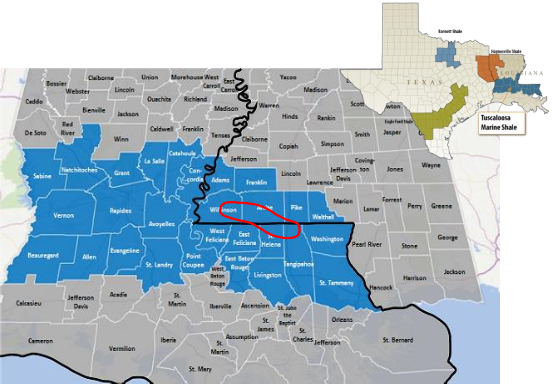The Tuscaloosa Marine Shale
One of the few remaining underdeveloped shale basins in the US with enormous future development potential
What is the Tuscaloosa Marine Shale?
The TMS is located onshore Louisiana and Mississippi – both well-established gas provinces. It remains one of the few undeveloped onshore unconventional oil plays in the US. It’s much earlier in evolution versus its peers but its early productivity is consistent with, or outperforms, other established plays. [Read more]
The TMS has delivered some mixed results with the early delineation wells, but we believe the production defined Core of this play to be highly prospective. Encana currently holds the largest position in the core of the TMS.
Why is Encana selling the asset?
Canada-based Encana has conducted an invite-only process to divest its TMS holding. It is an excellent and respected operator, with significant land holding in the TMS including one of the largest positions within the core of the play.
Encana included the following text in their announcement following the transaction
‘The transaction further tightens Encana’s portfolio and is consistent with the company’s focus on growing crude and condensate production from its core assets.’
Encana is primarily focused on producing natural gas, oil, and natural gas liquids (NGLs) in North America. Encana lists its core assets as the Eagle Ford, Permian, Duvernay and Montney unconventional shale plays.
Why is the TMS only at such an early stage? Why is it still so under-developed? What has it not taken off like neighbouring shale regions?
The TMS has a cretaceous shallow marine deposition similar to the other unconventional plays along the gulf of mexico coastline. As the ‘acreage land grab’ commenced with initial interest in the play, there were mixed productivity results. The TMS extends over a large area as shown in blue on the map below. Early activity delineated a core area that had very promising results but it was clear that well performance outside of this area, shown in red on the map below, demonstrated low productivity. In 2014 more wells were drilled within the core and they delivered strong productivity results whilst at the same time drilling and completion operations were becoming more consistent. And then in 2015, the falling oil prices meant a weaker environment for investment and development in this emerging unconventional shale play.

[Read more]
Initial participants in the play either withdrew as they realised that their acreage positions were outside of the core area or were poorly funded for the new environment post oil price fall in late 2014.
Our research on analysing drilling and completion data, production results and reserves to date has led us to believe that the core of the TMS is the ‘sweet spot’ of the entire play.
We believe a great opportunity to maximise returns on investment lies within an undeveloped play – of which there are only a few left.